Summary
The Onyx Industries' SENTRY remote weapon system (RWS) features an AI-enabled digital imaging system that can automatically detect and track potential targets, reporting them to a remote human operator who maintains control over fire decisions. MARSOC currently has two armed Q-UGVs undergoing testing.
While the technology is still in early stages, the evaluation of armed robotic dogs reflects a growing interest in small robotic unmanned ground vehicles for military use. However, the prospect of deploying these systems, even with human oversight, raises significant questions about the future of warfare and the potential risks and ethical implications of increasingly autonomous weapons.
MARSOC has provided a statement clarifying that weaponized payloads are just one of many use cases being evaluated and that the command adheres to all Department of Defense policies concerning autonomous weapons. As these armed robotic systems continue to evolve, addressing ethical concerns and ensuring their use aligns with established policies and international law will be crucial.
System Under Test
Ghost Robotics' Q-UGVs (Quadrupedal Unmanned Ground Vehicles):
- Developed by Ghost Robotics, a company specializing in advanced robotics
- Mid-sized, agile, and durable all-weather ground drones
- Designed for various applications, including remote inspection, Intelligence, Surveillance, Reconnaissance (ISR) missions, mapping, distributed communications, and persistent security
- Can operate in a wide range of unstructured urban and natural environments
- Developed by Onyx Industries, a defense technology company
- Features an AI-enabled Digital Imaging System (DIS) that can automatically detect and track potential targets, including people, drones, and vehicles
- Utilizes an X360 Pan/Tilt Gimbal stack for full electro-optical/infrared capability
- Includes a Remote Actuated Weapon (RAW) that accepts standard-size magazines and drums in various calibers (e.g., 7.62x39mm and 6.5mm Creedmoor)
- Maintains human-in-the-loop control for fire decisions, reporting potential targets to a remote human operator who can be located anywhere in the world
- Cannot make autonomous firing decisions
Robot dogs armed with AI-aimed rifles undergo US Marines Special Ops evaluation | Ars Technica
The future of warfare — Quadrupeds being reviewed have automatic targeting systems but require human oversight to fire.
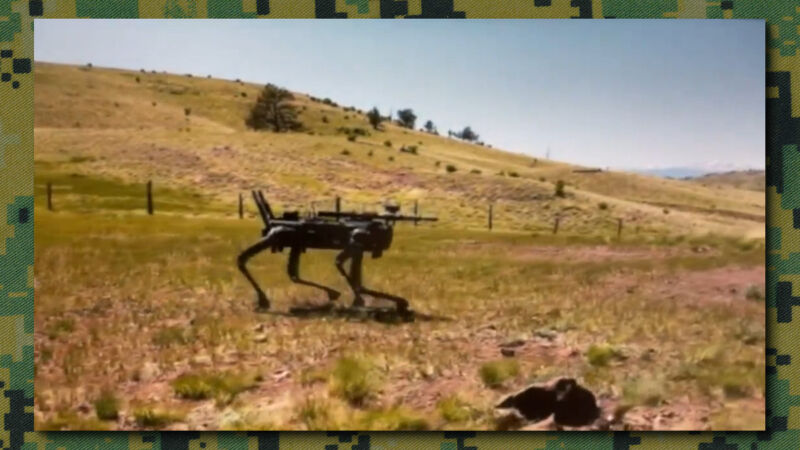
Enlarge / A still image of a robotic quadruped armed with a remote weapons system, captured from a video provided by Onyx Industries.
The United States Marine Forces Special Operations Command (MARSOC) is currently evaluating a new generation of robotic "dogs" developed by Ghost Robotics, with the potential to be equipped with gun systems from defense tech company Onyx Industries, reports The War Zone.
While MARSOC is testing Ghost Robotics' quadrupedal unmanned ground vehicles (called "Q-UGVs" for short) for various applications, including reconnaissance and surveillance, it's the possibility of arming them with weapons for remote engagement that may draw the most attention. But it's not unprecedented: The US Marine Corps has also tested robotic dogs armed with rocket launchers in the past.
MARSOC is currently in possession of two armed Q-UGVs undergoing testing, as confirmed by Onyx Industries staff, and their gun systems are based on Onyx's SENTRY remote weapon system (RWS), which features an AI-enabled digital imaging system and can automatically detect and track people, drones, or vehicles, reporting potential targets to a remote human operator that could be located anywhere in the world. The system maintains a human-in-the-loop control for fire decisions, and it cannot decide to fire autonomously.
On LinkedIn, Onyx Industries shared a video of a similar system in action.
In a statement to The War Zone, MARSOC states that weaponized payloads are just one of many use cases being evaluated. MARSOC also clarifies that comments made by Onyx Industries to The War Zone regarding the capabilities and deployment of these armed robot dogs "should not be construed as a capability or a singular interest in one of many use cases during an evaluation." The command further stresses that it is aware of and adheres to all Department of Defense policies concerning autonomous weapons.
The rise of robotic unmanned ground vehicles
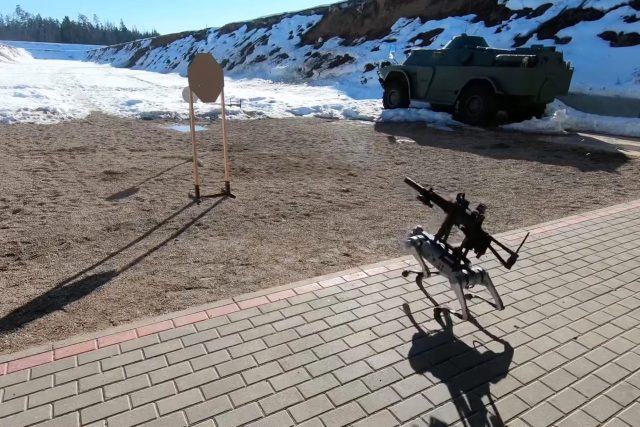
Enlarge / An unauthorized video of a gun bolted onto a $3,000 Unitree robodog spread quickly on social media in July 2022 and prompted a response from several robotics companies.
Alexander Atamanov
The evaluation of armed robotic dogs reflects a growing interest in small robotic unmanned ground vehicles for military use. While unmanned aerial vehicles (UAVs) have been remotely delivering lethal force under human command for at least two decades, the rise of inexpensive robotic quadrupeds—some available for as little as $1,600—has led to a new round of experimentation with strapping weapons to their backs.
In July 2022, a video of a rifle bolted to the back of a Unitree robodog went viral on social media, eventually leading Boston Robotics and other robot vendors to issue a pledge that October to not weaponize their robots (with notable exceptions for military uses). In April, we covered a Unitree Go2 robot dog, with a flame thrower strapped on its back, on sale to the general public.
The prospect of deploying armed robotic dogs, even with human oversight, raises significant questions about the future of warfare and the potential risks and ethical implications of increasingly autonomous weapons systems. There's also the potential for backlash if similar remote weapons systems eventually end up used domestically by police. Such a concern would not be unfounded: In November 2022, we covered a decision by the San Francisco Board of Supervisors to allow the San Francisco Police Department to use lethal robots against suspects.
There's also concern that the systems will become more autonomous over time. As The War Zone's Howard Altman and Oliver Parken describe in their article, "While further details on MARSOC's use of the gun-armed robot dogs remain limited, the fielding of this type of capability is likely inevitable at this point. As AI-enabled drone autonomy becomes increasingly weaponized, just how long a human will stay in the loop, even for kinetic acts, is increasingly debatable, regardless of assurances from some in the military and industry."
While the technology is still in the early stages of testing and evaluation, Q-UGVs do have the potential to provide reconnaissance and security capabilities that reduce risks to human personnel in hazardous environments. But as armed robotic systems continue to evolve, it will be crucial to address ethical concerns and ensure that their use aligns with established policies and international law.
US Marines Test Robot Dogs With AI-Enabled Rifles
The US Marine Forces Special Operations Command recently tested four-legged unmanned ground vehicles (UGVs) armed with artificial intelligence-enabled rifles.
The test, which was conducted at an unknown location, was made public by Eric Shell, an official from Virginia-based firm Onyx Industries, which supplied the AI-enabled weapon.
He said the US Marine command has two Vision 60 quadrupedal UGVs from Ghost Robotics fitted with gun systems based on Onyx’s SENTRY remote weapon system.
The rifle reportedly uses an AI-assisted Digital Imaging System to automatically detect targets before receiving authorization from a human operator to engage.
It also boasts an X360 Pan/Tilt Gimbal stack for electro-optical/infrared capability and what the company calls a Remote Actuated Weapon to aid in scanning people, vehicles, and drones.
Onyx said the trial will help “revolutionize the way we approach unmanned defense technology” for improved precision and safety.
Advantages
Integrating weapons systems into four-legged UGVs is not a new practice for the military.
The US Army was the first to announce it was considering equipping its Vision 60 Q-UGVs with the Next-Generation Squad Weapon.
The move is said to have numerous advantages, including providing increased safety for soldiers as robot dogs can be deployed for highly dangerous operations.
These cutting-edge platforms can fit into tight spaces such as tunnels and trenches, compared to other military ground vehicles.
They can also be used for clearing mined or booby-trapped areas to minimize risk to soldiers.
“Together, we are pushing the boundaries of innovation and redefining the future of unmanned systems,” Shell said.
Robot Dogs with AI-Targeting Rifles Now Under US MARSOC Testing
US Marine Special Ops Evaluates Armed Robotic Dogs for Future Combat Roles
The United States Marine Forces Special Operations Command (MARSOC) is currently assessing the potential of armed robotic “dogs” developed by Ghost Robotics and armed with Onyx Industries’ weapon systems. These quadrupedal unmanned ground vehicles (Q-UGVs) equipped with AI-targeting rifles are undergoing a rigorous evaluation process to determine their suitability for various military applications, including reconnaissance, surveillance, and remote engagement.
The robotic dogs tested are not autonomous weapons but function under the strict oversight of human operators, requiring explicit human approval before firing. This is in line with the Department of Defense’s commitment to keeping a human in the loop in decision-making processes involving lethal force. The technology incorporated into these robots includes Onyx’s SENTRY remote weapon system (RWS), capable of detecting and tracking potential targets through an advanced AI-enabled digital imaging system.
The deployment of robotic systems in military operations reflects a broader trend towards integrating more autonomous technology into combat scenarios. This move aims to enhance operational capabilities while minimizing risks to human soldiers. However, the introduction of such technologies also brings ethical and operational challenges, particularly concerning the control and use of lethal force in combat scenarios.
MARSOC’s evaluation of the Q-UGVs also includes broader considerations regarding the strategic use of unmanned systems in combat. These evaluations will likely influence future military policies on the use of robotic and autonomous systems, ensuring that advancements in military technology align with ethical standards and strategic objectives.
Expanded Coverage:
Rifle-Armed Robot Dogs Now Being Tested By Marine Special Operators (Updated)
The United States Marine Forces Special Operations Command (MARSOC) looks to be the first organization within the U.S. military to be using rifle-wielding "robot dogs." Other armed robotic K-9s have been explored by the U.S. military and shown off by foreign countries, in the recent past.
Eric Shell, head of business development at Onyx Industries which supplied the gun system for the dogs, confirmed to TWZ on the floor of SOF Week that they are in use with MARSOC. Shell noted that MARSOC has two robot dogs fitted with gun systems based on Onyx's SENTRY remote weapon system (RWS) — one in 7.62x39mm caliber, and another in 6.5mm Creedmoor caliber. It's unclear precisely how many other robotic dogs MARSOC may have at present, however, it appears likely that the two equipped with SENTRY are being tested by the command.
Video footage released by Onyx Industries showing one of MARSOC's robot dogs can be seen here.
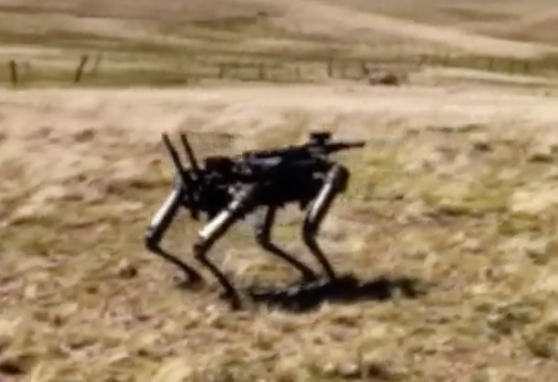
According to Shell, MARSOC's four-legged friends are "doing tunnel work, as well as perimeter security," but he could not specify where precisely.
The underlying robot dog doing this tunnel work for MARSOC is Ghost Robotics' Vision 60 quadrupedal unmanned ground vehicle, or Q-UGV, Shell said.
Ghost Robotics describes its Q-UGV as a "mid-sized high-endurance, agile and durable all-weather ground drone for use in a broad range of unstructured urban and natural environments for defense, homeland and enterprise applications." Vision 60 is designed for tasks such as remote inspection, Intelligence, Surveillance, Reconnaissance (ISR) missions, mapping, distributed communications, and persistent security. The company has worked with various entities to explore different defense and security applications for Q-UGV in the past, which you can read more about in this past War Zone feature.
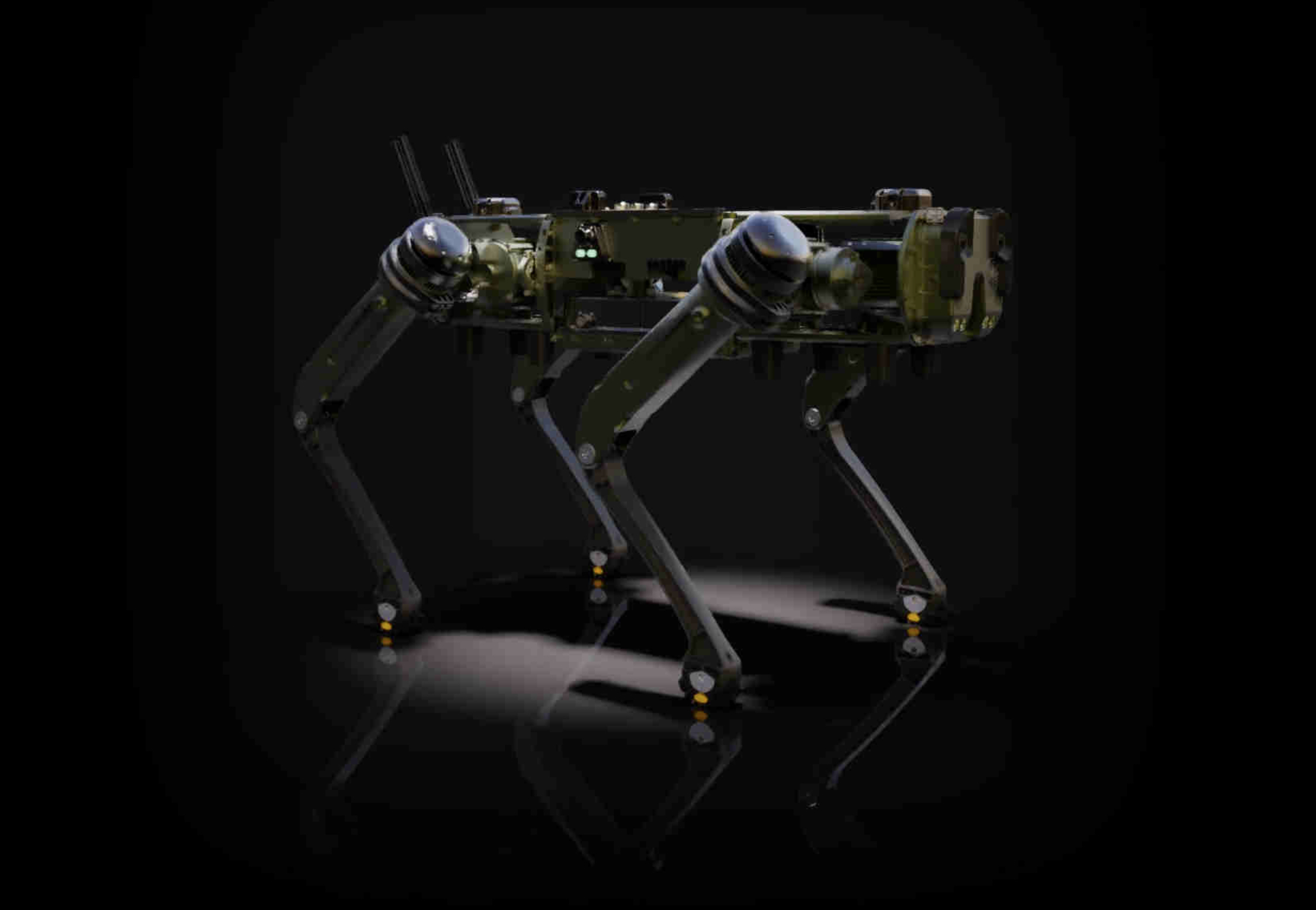
In 2021, for example, we saw Ghost Robotics team up with SWORD International to create what the companies call the Special Purpose Unmanned Rifle, or SPUR. That system saw SWORD's 6.5mm Creedmoor gun fixed atop Ghost Robotics' Q-UGV. Since then, other types of robot dogs have also emerged armed with guns, as well as examples sporting rocket launchers, one of which has been tested by the Marines.
The Q-UGVs currently being tested by MARSOC, on the other hand, are configured with Onyx's SENTRY RWS. The integrated system combines Onyx's X360 Pan/Tilt Gimbal stack (providing full electro-optical/infrared capability), an AI-enabled Digital Imaging System (DIS), and what the company terms RAW (Remote Actuated Weapon). According to Onyx, the Remote Actuated Weapon in its various calibers accepts standard-size magazines and drums.

As Shell explained, the autonomous weapon system will "scan and detect targets... [locking] on [to] drones, people, [and] vehicles." As it features man-in-the-loop fire control, it will alert the operator once a target has been identified, letting the human decide whether to engage or not.
SENTRY can be operated over "any comms network... you can really operate this from anywhere in the world, keeping the operator kind of out of danger," Shell said.
A non-kinetic, sensor-only configuration featuring the Gimbal stack is also available, he pointed out.
For MARSOC, there's a lot that translates from their use of real-life dogs as part of highly dangerous operations to those of the robotic kind; particularly of the autonomous sort offered by Ghost Robotics and Onyx Industries. Both, for example, are able to fit into tight spaces where humans cannot, expanding the intelligence and information-gathering possibilities in the field.
Their use also removes the risk posed by certain types of work for human operators, particularly with regard to scouring tightly confined tunnels and trenches where close-quarters combat is extremely dangerous. Blazing a trail through mined or booby-trapped areas will also be highly valuable applications for these mechanized K-9s. That MARSOC robot dogs coupled with Onyx's SENTRY RWS means they can autonomously select potential targets in those environments, prior to a human-in-the-loop safely engaging them from afar.
Moreover, their usefulness in providing persistent perimeter security has already been explored by other branches of the U.S. military. Unarmed Q-UGVs have notably been used by the U.S. Air Force for scouting purposes at bases like Tyndall and Nellis Air Force Bases. Moreover, Shell indicated on the floor of SOF Week that an unspecified number of Q-UGVs teamed with the SENTRY system are being experimented with at Dyess Air Force Base for perimeter security.
In line with the broader trend towards small, uncrewed platforms on the ground and in the air, armed robotic dogs have also emerged in other countries, too, including China and Russia.
While further details on MARSOC's use of the gun-armed robot dogs remain limited, the fielding of this type of capability is likely inevitable at this point. As AI-enabled drone autonomy becomes increasingly weaponized, just how long a human will stay in the loop, even for kinetic acts, is increasingly debatable, regardless of assurances from some in the military and industry.
Just last week, at the Modern Day Marine symposium, the head of the USMC's advanced robotics initiative laid out the vision for what the future of robotics-heavy warfighting will look like — including the use of robot dogs. It's becoming very clear that what was once fodder for science fiction tales is now quickly becoming a battlefield reality, and highly agile robot dogs, capable of going into extremely risky or inaccessible areas, and even dealing out deadly force in the process, are now on the horizon.
UPDATE: 5/8/2024
MARSOC has provided the following statement to TWZ regarding its robot dogs:
"The Q-UGV, referred to as a 'robot dog,' is under evaluation by MARSOC as one of many pieces of technology in ground robotics evaluation. MARSOC is not fielding this capability at this time. Weapons are just one of many potential payloads for this piece of technology and others may include ISR or EW payloads. MARSOC is aware of and follows all DoD policy on autonomous weapons and comments by Onyx Industries may be more indicative of their current or future offerings. Those comments should not be construed as a capability or a singular interest in one of many use cases during an evaluation."
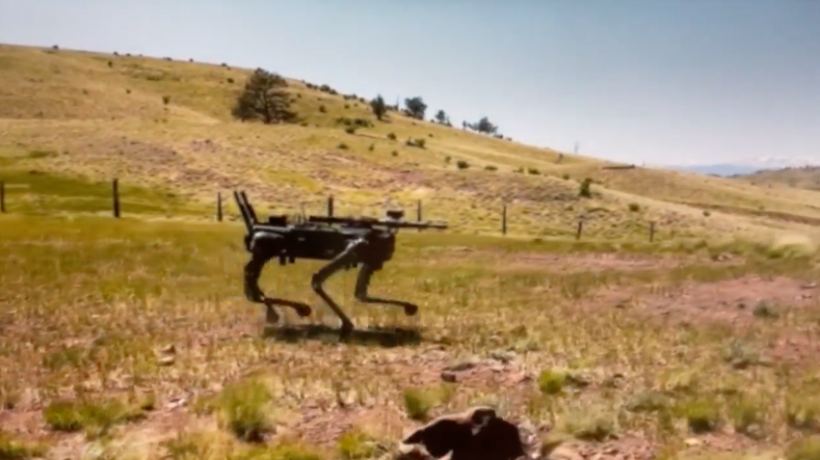


No comments:
Post a Comment